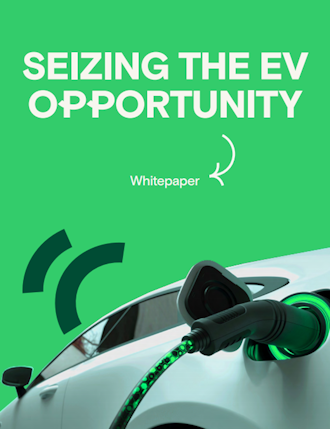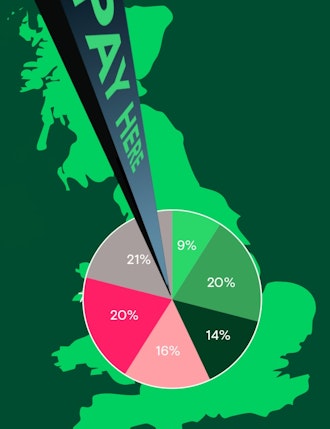Key Insights
-
Retail automation and digital payments significantly reduce energy use and environmental impact by cutting down on cash handling, paper receipts, and traditional payment infrastructure.
-
Cloud-based POS systems and payment platforms help businesses lower their carbon footprints by reducing physical hardware needs and optimizing energy efficiency.
-
Sustainable payments in electric vehicle (EV) charging eliminate the need for cash and cards, supporting greener operations and reducing reliance on energy-intensive payment infrastructure.
Don't have time to read more now? Sign up to our newsletter to get the latest insights directly in your inbox.
Payment technology has moved far beyond making things faster and easier - it's now got a bigger agenda in helping the world be more sustainable. By transitioning to cloud-based platforms, companies are reducing their carbon footprints while creating greener operations. Initiatives like retail automation and EV payments are certainly helping, but how, exactly? The way we pay is getting a green makeover, so let’s explore this in greater detail…
How retail automation is reducing energy use
Retail automation refers to the use of technology to streamline operations and reduce human involvement in retail settings. By automating tasks like self-checkout and digital payment processing - where transactions are handled through online systems, mobile apps, or contactless methods - businesses can cut down on the need for physical cash handling and traditional payment terminals. Cash, in particular, has a significant environmental cost - each $1 USD bill produced generates an annual environmental impact valued at $0.26 per note. Reducing reliance on physical cash through automation cuts energy use, whilst helping lower the ecological footprint tied to cash production and circulation.
What’s more, digital payment processing and payment orchestration streamlines transactions further by securely transferring funds electronically, cutting down on energy-intensive activities like running card machines and maintaining cash registers, not to mention managing physical receipts, (which, incidentally, is a huge contributor to worldwide CO2 emissions, adding an estimated 28,000 tonnes of CO2 to the atmosphere each year, which is equivalent to 10,000 flights across the globe).
The adoption of automation in sectors like e-mobility, where systems efficiently rent out electric bikes and scooters, exemplifies how technology promotes greener choices by enabling unattended payments and eliminating the need for person-to-person interaction and cash.
How POS systems in restaurant settings promote energy efficiency
Modern POS systems in restaurants play a key role in promoting energy efficiency by reducing the need for physical resources. By offering digital receipts, they significantly cut down on paper usage, helping reduce waste. Additionally, cloud-based POS systems allow data to be processed and stored off-site in energy-efficient data centers, eliminating the need for power-hungry, on-site servers. This reduces both hardware requirements and the energy used to maintain traditional infrastructure.
POS systems also streamline operations and optimize resource use. Integrated inventory management tools help restaurants reduce food waste by tracking stock in real time and preventing over-ordering. Furthermore, these systems combine multiple functions into a single device, reducing the number of machines needed and lowering overall energy consumption. Automation of processes like payment handling and kitchen orders improves efficiency, minimizing the energy used during daily operations while contributing to a restaurant's overall sustainability.
This transition toward cloud-based systems, like those offered by Aevi’s platform, minimizes hardware use and contributes to energy efficiency, cutting back on the physical infrastructure traditionally needed to support payment systems.
How payments in the EV are becoming more sustainable
EVs are essential in reducing global emissions, but their success depends on two things: sustainable production and an efficient, eco-friendly payment infrastructure. Over the last few years, payments at EV charging stations have become so much more sophisticated, eliminating the need for cash and cards, which certainly helps reduce physical waste and energy consumption.
To give some context on this, the cloud-based payment orchestration that we offer here at Aevi plays a critical role in enabling smooth, cashless transactions at EV charging stations. As outlined in our EV whitepaper, these systems help streamline in-person payment processes, contributing to the future of sustainable transportation. Additionally, this cloud-based platform assists energy retailers by consolidating multiple systems into cloud-based solutions, drastically reducing the need for energy-intensive on-site hardware. This reduced infrastructure helps businesses lower their environmental footprint while supporting the growth of sustainable EV infrastructure.
Why digital payments are greener than cash or cards
Let’s face it, traditional payment methods like cash (paper) and credit/debit cards (plastic) are a big part of the problem when it comes to environmental damage. Paper production equals deforestation, massive energy and water consumption, and pollution from start to finish - from manufacturing to transportation. Paper waste makes up 26% of landfill trash and plastic has left a permanent scar on the planet, with 7 billion tons of plastic sitting in landfills and 14 million tons finding its way into our oceans every year.
Digital payments, on the other hand, require fewer physical resources compared to traditional cash and card methods. They help conserve natural resources by eliminating the need to print cash, coins, or cheques, saving trees, water, and metals. Since there’s no physical currency or cards to dispose of, digital payments also reduce waste.
Additionally, by skipping the manufacturing, printing, and transportation processes involved with traditional payments, digital methods cut down on carbon emissions. Overall, digital transactions have a much smaller environmental footprint than cash or card payments.
Cloud-based platforms like Aevi’s are crucial here. By offering a central management system for payments, companies can reduce their physical and environmental footprints. The shift to cloud also eliminates the need for frequent on-site visits, reducing travel-related emissions.
Challenges around the implementation of greener tech
While digital payments and greener tech promise a more sustainable future, the road to widespread adoption isn’t without obstacles. One of the biggest hurdles is accessibility, particularly for underbanked populations. In many parts of the world, millions of people still don’t have access to basic financial services, let alone digital payment platforms. In these regions, the push towards greener payment methods risks deepening financial exclusion, leaving those communities even more isolated from the benefits of modern technology. If we want greener payments to be truly inclusive, we need to address this head-on by expanding financial access and creating systems that work for everyone, not just the digitally savvy.
For small businesses, the cost of transitioning to greener tech can be prohibitive. Cloud-based systems, smartPOS platforms, and advanced payment tech all come with a price tag that many SMEs simply can’t afford. Without the right financial support or incentives, these businesses may find themselves priced out of the sustainability movement, further entrenching the divide between those who can invest in greener solutions and those who can’t.
On top of that, consumer reluctance still presents a challenge. Despite the convenience and benefits of digital payments, some people are skeptical, worried about data security, concerned over privacy, or just attached to the familiarity of cash and cards. And let’s not forget, older generations and tech-averse consumers may resist the shift entirely, slowing progress.
To overcome these barriers, there needs to be a concerted effort to broaden accessibility and offer financial assistance where it’s needed. Education and outreach will also play a pivotal role in building consumer confidence and encouraging the adoption of more sustainable payment options.
What does the future look like for sustainable payments?
Looking ahead, innovations in payment technology will continue to support the global sustainability movement. The Internet of Things (IoT) will play a key role, with smart devices optimizing energy use in real time. Cloud-based systems are at the forefront of this change, offering energy-efficient solutions for data processing and device management. By consolidating hardware, businesses reduce electronic waste and lower their overall energy consumption.
Energy-efficient data centers will shape the future of payments, ensuring that sustainability and digital innovation go hand-in-hand.
Are you ready to make your payment processes greener and more efficient? Reach out to the team here at Aevi and explore how you can integrate sustainable, future-ready solutions into your existing payment infrastructure.
Interested in reading more around this subject? Here are some useful articles…













